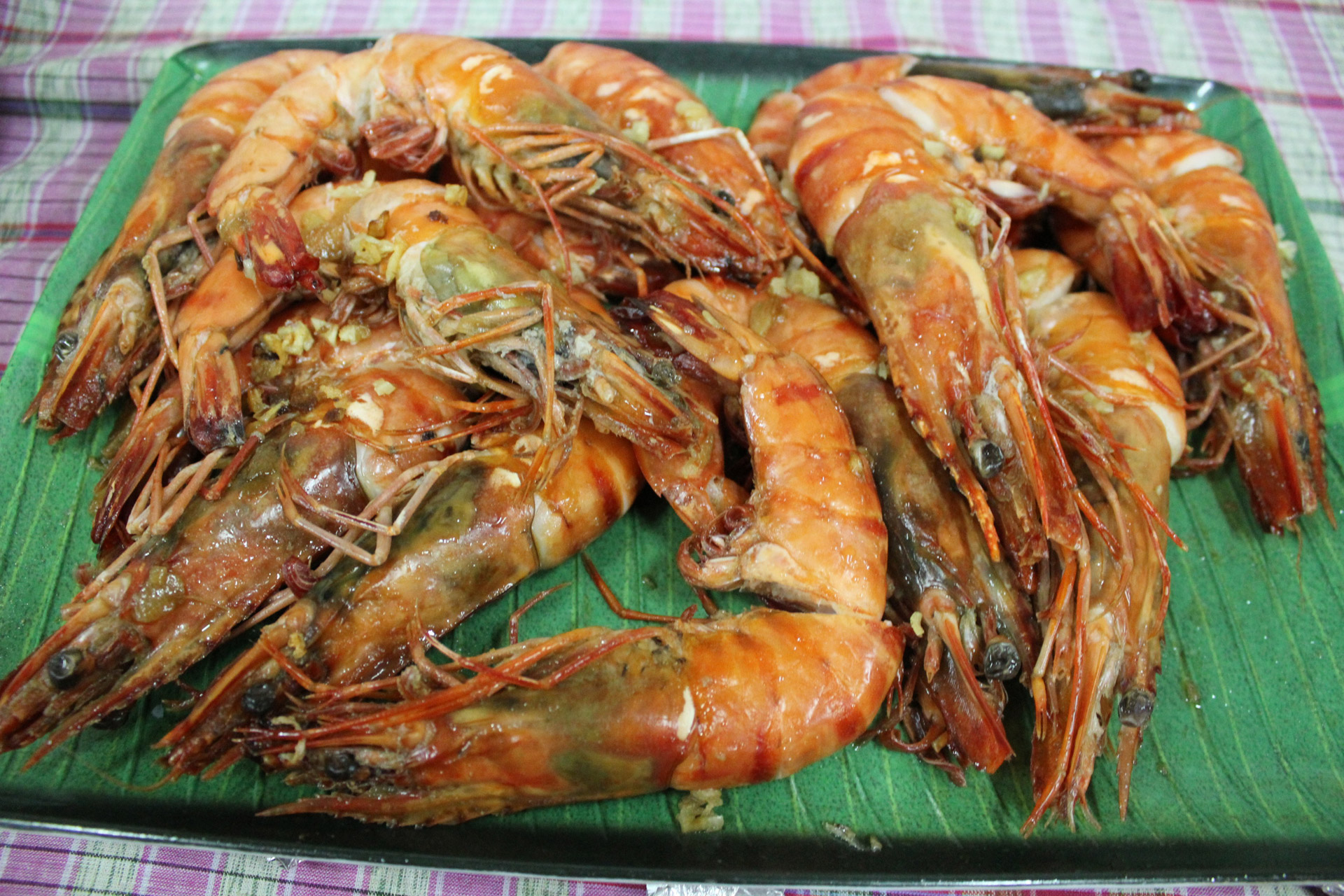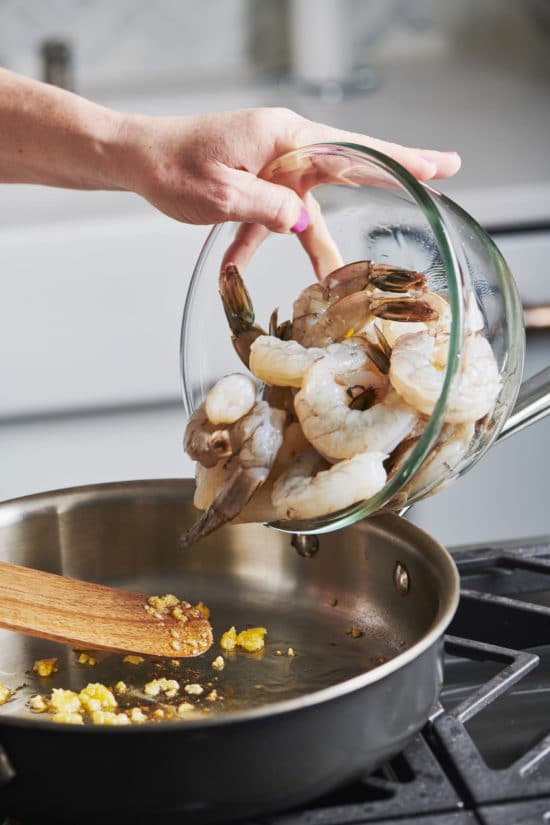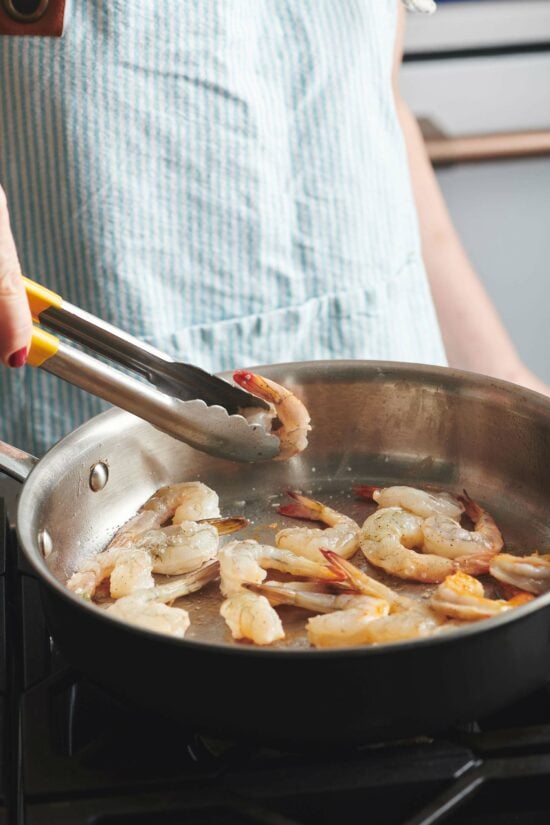Simple sautéed shrimp can be a main course on their own. They are also wonderful added into grain salads, stir fries, and more.
Shrimp are exceedingly popular for good reason. Delicately flavored, slightly sweet, a bit salty, with an appealing firm-crisp texture. They cook up quickly in a skillet or pan, and can star in many dishes and many cuisines. Also, if you can get the big ones (which are usually a treat, but man, they’re worth it), those are not only a treat but also a show-stopper.
As a main dish, simple sautéed shrimp can be served on their own or over rice, pasta, grits, or polenta. They can be made with a splash of lemon juice, some zest, red pepper flakes, parsley, or another fresh herb. Sautéed shrimp are also wonderful added into grain salads, stirred into risottos, and as part of stir fries. Or, think about finishing these with a drizzle of Easy Lemon Butter Sauce.
A bag of frozen shrimp is one of the money-in-the-bank ingredients that I always have on hand. Don’t think for a second that frozen shrimp isn’t good; almost all of it has been frozen and thawed before it gets to our kitchens. If you’re lucky enough to live near the coast, you might be able to find fresh, never-frozen shrimp. If you do, by all means, grab them. But otherwise, even most of the shrimp you buy at a good fish store has been frozen.
Make sure you defrost shrimp in your refrigerator, not on the counter, for safety. You can also defrost them by running cold water over them in a colander.
Shrimp range widely in size. They are sold by the quantity per pound, and then given corresponding names like medium or jumbo. However, the name attached to the quantity per pound varies from brand to brand, market to market.
This is a good scale to use. The two numbers show a range of how many shrimp that size will produce per pound. Most of the time, a count per pound is a better way to measure something than a name.
For some recipes, smaller are just fine, possibly even more desirable. For example, if you’re just going to cut them up for a shrimp stir-fried rice dish, you shouldn’t spend extra money on bigger shrimp. However, if you can afford it and want to make shrimp cocktail or shrimp scampi, the bigger shrimp really stand out. They are usually juicier but still have a snappy texture. They are also harder to overcook.
It’s up to you whether you want to leave the tails on or off. It depends on how you plan to serve and eat the shrimp. You can eat the shrimp with your hands more easily if you leave the tails on. They look bigger that way. But do remember to put out a small dish for people to discard the tails afterwards. No tails means the shrimp are easier to eat as part of a dish, a pasta for instance.
How Long Should You Sauté Shrimp for Perfectly Cooked Seafood?
Shrimp is one of the most popular seafood ingredients, loved for its sweet flavor, firm texture, and versatility. It can be prepared in endless ways – grilled, baked, boiled, fried, or sautéed. Sautéing is one of the quickest and easiest cooking methods for shrimp. It takes just minutes to go from raw to perfectly cooked. But how long exactly should you sauté shrimp to get the best results?
As an avid home cook and seafood lover, I’ve experimented extensively to determine the ideal sauté time for shrimp of all sizes The timing depends on several factors, including the size of the shrimp, thickness of the pan, and intensity of heat Here, I’ll share my tips and tricks to help you nail perfectly sautéed shrimp every time.
Shrimp Sizes and Counts
Before we get into timing, it’s important to understand shrimp sizes. Shrimp are categorized by “count”, which refers to the number of shrimp per pound. The smaller the number, the larger the shrimp. Common sizes include:
- Colossal or Super Colossal: under 12 or under 10 count per pound
- Extra Jumbo: under 15 count per pound
- Jumbo: 16-20 count per pound
- Extra Large: 21-25 count per pound
- Large: 26-30 count per pound
- Medium: 36-40 count per pound
- Small: 41-50 count per pound
When sautéing shrimp, I recommend using Large, Extra Large or Jumbo sizes. The timing below is based on these sizes. Very small shrimp like 51-60 count can overcook quickly when sautéed.
Preparing the Shrimp
Most shrimp is sold shelled but with the tails on. For sautéing, I prefer to buy shrimp peeled and deveined – this minimizes prep time. If you purchase shell-on shrimp, you’ll need to remove the shell prior to cooking. Simply grasp the legs between your fingers and pull off the shell. Use a paring knife to cut along the back and remove the vein. Rinse the shrimp under cold water and pat very dry before sautéing.
If you buy frozen shrimp, make sure to thaw completely before sautéing. I like to thaw frozen shrimp overnight in the fridge. You can also thaw in a bowl of cold water, changing the water every 5 minutes.
Seasoning the Shrimp
Always season shrimp before sautéing. I like to toss the shrimp with seasoning in a bowl prior to cooking. This evenly coats the shrimp and allows the flavors to penetrate.
My go-to seasoning is a simple blend of smoked paprika, garlic powder, onion powder and cumin. Salt and pepper is also excellent. Other options include lemon-pepper, Cajun spice, jerk seasoning, chili powder or herb blends. Get creative with your own spice combos!
Heating the Pan
Use a heavy skillet or sauté pan when cooking shrimp. I prefer cast iron or stainless steel. The pan should be large enough to hold the shrimp in a single layer without overcrowding. Overcrowding causes the shrimp to steam rather than sauté.
Heat the pan over medium-high heat until very hot. I like to use a combination of olive oil and butter for flavor, but you can use all oil if you prefer. Melt 1-2 Tbsp fat in the skillet before adding the shrimp. Make sure it coats the bottom of the pan.
Once the pan is hot and the fat shimmers, you’re ready to add the shrimp. Resist the urge to stir or move the shrimp right away. Let them sear undisturbed for at least 1 minute before flipping. This helps develop a nice crust.
Sauté Times per Shrimp Size
Here are my recommended sauté times based on years of cooking shrimp. These times are for peeled, deveined shrimp sautéed in a very hot cast iron or stainless steel skillet.
Large Shrimp (26-30 count):
- 2 minutes per side
- Flip/stir halfway through
Extra Large Shrimp (21-25 count):
- 2-3 minutes per side
- Flip/stir halfway through
Jumbo Shrimp (16-20 count):
- 3-4 minutes per side
- Flip/stir halfway through
Jumbo shrimp may need a little longer since they are thicker. But never sauté any shrimp longer than 5 minutes total, max. It’s easy to overcook them!
Test for Doneness
The best way to test shrimp for doneness is to cut into one and check the interior. Shrimp change color from grey to opaque pink/white when cooked through. The center should be opaque but still ever so slightly translucent when perfectly cooked.
Immediately remove the shrimp from the skillet once cooked. They will continue to cook off heat. I like to arrange them on a serving platter and tent with foil to keep warm.
Serving Suggestions
Sautéed shrimp tastes fantastic on its own, perhaps finished with a squeeze of lemon. For a complete meal, I love to serve it over rice, quinoa or pasta. It also makes a great taco or fajita filling. Leftovers are delicious tossed into salads, grain bowls or stir fries.
My golden rules for perfectly sautéed shrimp:
- Use a heavy, well-heated pan
- Don’t overcrowd the pan
- Flip/stir halfway through
- Remove from heat as soon as opaque
- Immediately transfer to a platter

How to Know When Shrimp Are Cooked
The shrimp are ready to be taken off the heat when they have turned an opaque pinkish-white color and the inside is just barely white all the way through, with a pink spot here and there. They will keep cooking a little after you take them off the heat and even after you take them out of the pan, so the middle will be done.
Also try Air Fryer Shrimp.
How to Saute Shrimp
Most of the time, I like to cook shrimp with a mix of butter and olive oil. But you can use all oil (like when you’re making a stir fry, which usually calls for vegetable or peanut oil) or all butter. Either/or, or a combo works perfectly.
Heat the butter and/or oil in very large skillet over medium heat. Sauté the garlic for 1 minute, then add the shrimp and season with salt and pepper. Space out the shrimp so they are in a single layer. After a few minutes of cooking, stir or flip the shrimp and move them around so that the raw sides are now facing the pan.

Tongs are great for this. Move quickly and turn them in the order they came out of the pan, keeping an eye out for hot spots and flipping the shrimp that are cooking faster than the rest. This will allow the whole batch of shrimp to cook more evenly. For smaller shrimp, you might want to use a spatula instead of flipping each one by hand, which takes more time.
Don’t crowd the pan — you want only a single layer of shrimp. Cook them in batches if necessary.

Extra-large shrimp need two to three minutes per side, large shrimp need three to four minutes per side.
